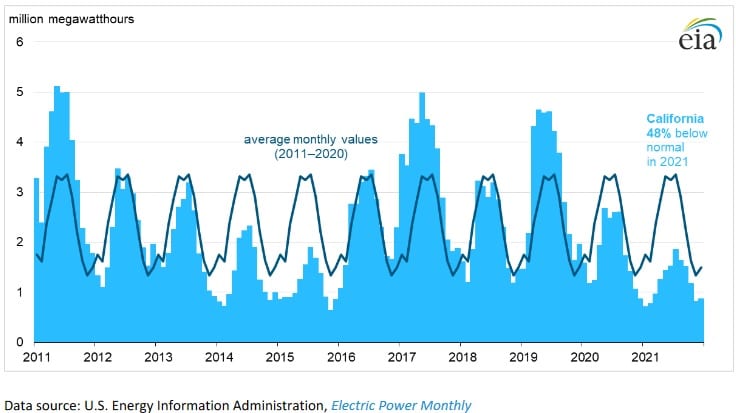California’s Hydroelectric Generation Expected to Decrease Due to Drought: EIA

Droughts in California are expected to reduce the state’s summer electricity generation from hydroelectricity, according to a May 26 report from the U.S. Energy Information Administration. The impact of drought is projected to cut hydropower generation by nearly 50 percent, in comparison to normal precipitation conditions.
The agency, in its report titled “Short-Term Energy Outlook Supplement: Drought Effects on California Electricity Generation and Western Power Markets” projects that the reduction in California’s hydroelectric generation, due to drought conditions, will alter the generation mix in the state, resulting in an increase in wholesale power prices in the West and higher carbon emissions.
Hydropower generation would contribute to 8 percent of California’s electricity generation in a drought year, compared to 15 percent during years with normal precipitation conditions. The reduction in hydropower generation will lead to an 8 percent increase in natural gas usage for electricity generation and a 6 percent rise in energy related carbon dioxide emissions in the state. Moreover, the reduction in hydropower and higher gas usage is expected to increase the wholesale electricity price throughout the West by an average of 5 percent.
Replacing low-cost hydroelectric power requires a change to more expensive natural gas generators and out-of-state power suppliers. Elevated gas prices across the U.S. are significantly increasing the cost of electricity generation. As a result, on-peak prices in Northern California, where most of California hydroelectric plants are located, are expected to increase by 7 percent, whilst Southern California on-peak prices are 5 percent higher.
As a result of the forecasted greater use of natural gas generation due to the drought, the agency expects carbon dioxide emissions, attributable to California’s summer electric demand to be 6 percent higher, representing an additional 978,000 tonnes of carbon dioxide.
EnerKnol Pulses like this one are powered by the EnerKnol Platform—the first comprehensive database for real-time energy policy tracking. Sign up for a free trial below for access to key regulatory data and deep industry insights across the energy spectrum.
ACCESS FREE TRIAL